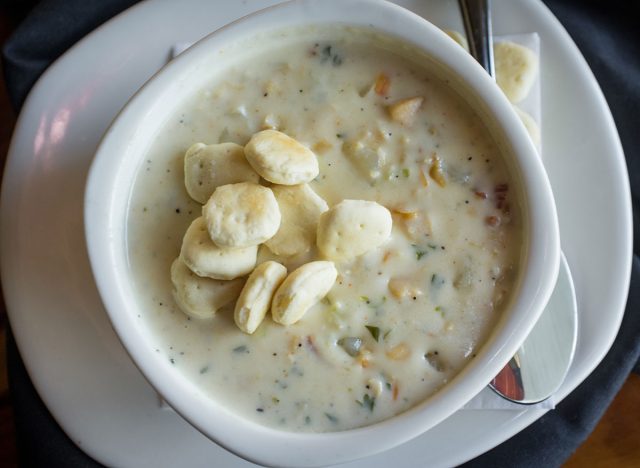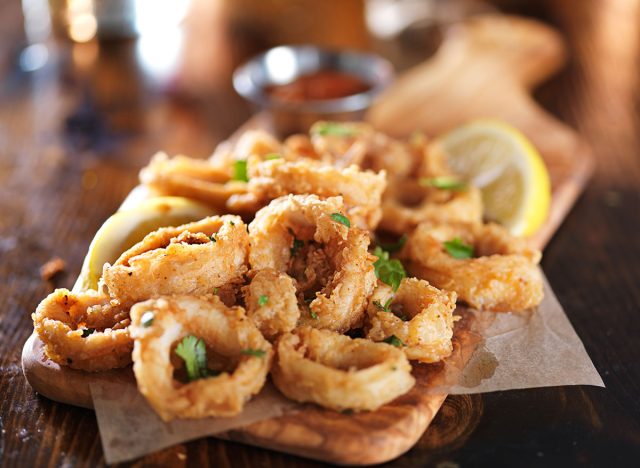The beauty of eating seafood is tri-fold: There are tons of fish and crustaceans to choose from so you’re never eating the same thing, they can be served simply or sauced up with almost any kind of seasoning, and they provide a wide range of nutritional benefits. For example, fish are the top food sources of omega-3 fatty acids: nutrients that are linked to brain health, lowering heart disease risk, and more. Typically speaking, seafood is a great addition to your diet. But, that’s only if you know how to choose the right kinds.
When it comes to selecting your seafood, you want to ensure that you’re picking quality. The same goes for ordering off of a menu at a seafood restaurant. While these businesses provide a plethora of dishes ranging from shrimp and crab to trout and salmon that may sound tasty, not every item is going to be a grade-A meal.
For example, one of the most popular seafood soups you can order—clam chowder—contains some lower-quality ingredients. Specifically, clam chowder almost never uses fresh clams and heavily relies on canned clams. “[Clam chowder] may be considered as the lowest quality menu item at a seafood restaurant because the clam chowder is sometimes made from canned clams,” says Rusty Hansen, Professional Chef at Hunters Feast.


While there’s nothing wrong with using canned ingredients (in fact, there are many benefits of eating canned foods) the reason canned clams are considered to be a low-quality ingredient, in this case, is because evidence has shown the presence of a harmful chemical in the cans.
In a July 2022 discovery by the Food and Drug Administration, as reported by the Environmental Working Group (EWG), canned clams were shown to have high levels of perfluorooctanoic acid (PFOA), one of the most common members of a group of toxic, manmade “forever chemicals” known as PFAS that break down slowly over a long time. The chemical is also considered to be “possibly carcinogenic to humans” based on limited evidence that it is linked to testicular and kidney cancer risk, according to the American Cancer Society.
The levels of PFOA were so high in one brand’s canned clams product that the company issued a voluntary recall in response to the findings.
Based on the high levels of PFAS, the FDA warned people to reduce their consumption of canned clams to no more than 10 ounces per month; however, the government body also noted that seafood as part of a healthy diet, “provides many nutritional benefits that for children include brain development and boosted immune system, and for adults, heart and bone health benefits, as well as help in reducing the risk of certain cancers,” so you do not need to cut out seafood from your diet completely.
The use of canned clams isn’t the only reason you may want to skip over the soup. Chef Hansen continues to say that the other ingredients in clam chowder, namely flour, potatoes, and cream, are present in large quantities, completely overshadowing the clams. Chef Hansen continues to say that what this means for the cup of chowder is that there’s no real clam meat in the mix. He also advises that clam chowder also contains a lot of potatoes and is very “thick and heavy.” Overall, not making for a quality soup you’d want to sip on.
READ RELATED: Smita Bansal Height, Weight, Age, Body Statistics
Now that you’ve skipped the soup section on the menu, you may want to mosey on over to the appetizers, as there’s one item that veteran chef and current CEO of Griddle King, Michael East, believes there’s one other food to stay away from at a seafood restaurant: fried calamari.


“Personally, one of my favorite seafood items to cook has always been calamari,” he starts. “When I make it myself, I take great care to make sure the squid is cooked properly and doesn’t come out all rubbery and chewy. I also season the batter carefully to give the dish some depth of flavor, rather than being a bowl of bland, brown food.”
While this is the token method for preparing a fried calamari dish, Chef East says this is not the way all restaurants do it.
“Every time I order this item in a restaurant, it seems like the chef hasn’t taken these steps to ensure the calamari actually tastes good. It always seems to be undercooked, leaving the squid rubbery, or overcooked, in which case the batter is way too hard and crunchy.”
But despite the poor preparation and occasional lack of taste, old habits die hard, as East says he still orders this item pretty often.
“While I wouldn’t say this is the worst seafood menu, item it’s definitely the one that most chefs seem to get wrong, in my opinion.”
Kayla Garritano
Source:










